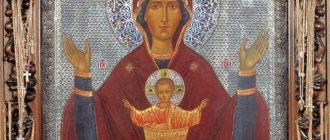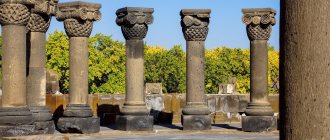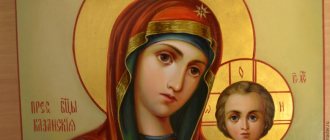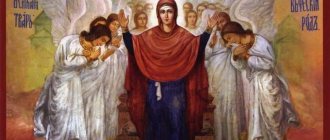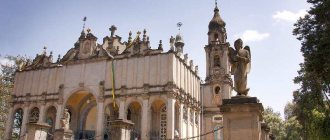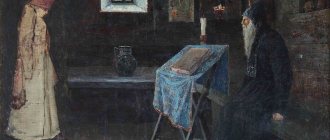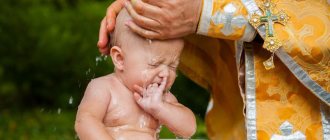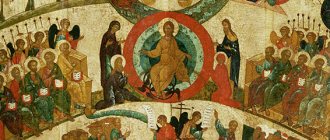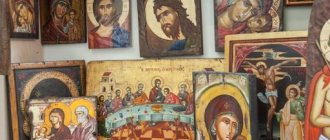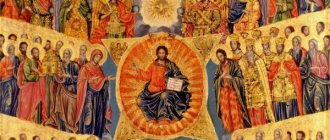July 31, 2022 Olga Kurpas Home page › Mother ›
Armenia today is a Christian country, in the culture of whose people religion occupies a fairly large place and, apparently, this has been the case for a very, very long time, long before the advent of Christianity.
- Horn of plenty - symbol of the mother goddess
- Goddess Arubani
- Goddess Astghik
The Mother of God is the heiress of a thousand-year-old culture of veneration of the maternal principle
The Armenian Christian Church belongs to the ancient Eastern churches, which separated from Orthodoxy and Catholicism back in 451.
The Armenian Church has its own characteristics in dogma and rituals. Armenian churches are very simple in design, the walls of the temples are not decorated with anything, there is only an altar with an icon or several icons.
We visited about a couple of dozen Armenian churches and what was very surprising was that on the main altar of all the churches there was the Mother of God with a baby in her arms.
And even in the main temple of the Armenian Church - in the Etchmiadzin Cathedral, the Mother of God and Child are depicted on the main altar.
In many churches, the image of the Mother of God was repeated - this is some kind of special Armenian ancient icon, where the Mother of God is wearing a scarf on her head, but there were also other images, also beautiful and neat, but almost always completely different than in Orthodoxy.
Armenian Mother of God in the Khor-Virap monastery on the left and in the Sevanavank monastery on the right
The same Armenian Mother of God in the Cathedral of St. Gregory the Illuminator in Yerevan on the left and a picture from a souvenir shop in Etchmiadzin on the right
On the left is the ancient face of the Virgin Mary from the chapel in the Khor Virap monastery, on the right is the modern face of the Virgin Mary from the Shokagat Church in Etchmiadzin
This undoubtedly indicates that in the culture of the Armenian people the maternal principle is of great importance, and the cult of fertility was and still is in great strength.
Our Lady Mary became the heir to a thousand-year-old culture of veneration of the fertile forces of mother nature; at present, she has become a single face of many previous mother goddesses of various religions that existed on the territory of Armenia in different years.
LiveInternetLiveInternet
Armenia is the first state in the world where the Christian religion became the state religion back in 301. Etchmiadzin translated from Armenian means “Place of the Descent of the Only Begotten” - it is believed that the second appearance of Jesus Christ took place here. The Armenian Church is the custodian of many relics, of which the Spear of Longinus and the Piece of the Wood of Noah's Ark are especially significant.The spear that pierced the side of Jesus Christ
According to the testimony of the Apostle John, one of the soldiers pierced the side of Jesus Christ who died on the cross with a spear (John 19:34). During the execution, a detachment commanded by a Roman soldier, centurion (centurion) Longinus, stood guard at the very foot of the Holy Cross. The warriors witnessed the last moments of the Lord's earthly life. These events shocked them. According to church tradition, Longinus pierced the ribs of the crucified Savior with a spear and received healing from the flowing blood and water of his sore eyes. Longinus believed in Christ and publicly confessed that “truly this is the Son of God.” He subsequently suffered martyrdom and was canonized. Longinus is the patron of all those suffering from eye diseases. Over the centuries, many secrets and legends have arisen surrounding the relic. It is believed that the Spear of Destiny gives the owner the ability to affirm goodness, achieve victories and perform superhuman deeds: “those who claim it as their own and discover its secret will take the fate of the world into their own hands to accomplish Good and Evil.” There are also several versions, besides Armenia, of the location of the Spear of Destiny: in Vienna, the Vatican, Krakow. Researchers call the Vatican one made in the 3rd century, the Krakow one - in the 4th century, the Vienna one - no earlier than the 7th century... In 2010, British scientists who examined the Shroud of Turin discovered a trace of a wound on the imprint of the body, similar to the one described in the Gospel. This wound was inflicted by a special type of spear, which was in the service of the heavily armed legionnaires of the Roman garrisons throughout the Empire. When comparing the imprint of the wound on the Shroud of Turin and the Spear of Longinus in Armenia, according to the Armenian media, it was established that not only the type of wound and spear corresponded, but also the size - in both cases it was 4.5 centimeters. British scientists dated this spear to the 1st century. Proponents of the opinion that the Spear of Longinus is in Armenia say that it was brought here by the Apostle Thaddeus, who preached and died a martyr’s death in Armenia in the second half of the 1st century AD. e. The alleged grave is located on the territory of the Armenian monastery of St. Thaddeus in northwestern Iran. Until the 13th century, the Holy Spear (Surb Geghard) was kept in the Ayrivank monastery, which was renamed Geghardavank (literally translated as “Monastery of the Spear”). Then the relic was transferred to the temple in Etchmiadzin. The cross in the center was made in the 15th century and symbolizes the crucifixion. The Spear of Longinus is now considered the main shrine of the Armenian Apostolic Church. During the preparation of Chrism, the Catholicos of All Armenians consecrates it to St. Miro. In his interview, Catholicos Karekin II confirmed the authenticity of the spear: “Its history can be traced back to Golgotha itself, where the blood of the Savior was shed. The monks cherish it as their greatest treasure. By praying near him, believers are even healed from cancer. But not once did the relic fall into the hands of villains who wanted to enslave humanity. After all, the Holy Spear is the key to peace... The Armenian Church is aware of its mission as the custodian of the greatest Christian shrine. Our people have always and at all times been faithful to Christ.” The documentary below covers the first 14 minutes of The Spear of Longinus:
Piece of Noah's Ark tree
As the Bible says, “the ark rested... on the mountains of Ararat” (Gen. 8:4). The Monk James, Bishop of Nizibia (died about 350), was the son of the Prince of Gethala (Armenia) and received a good education. From his youth, he fell in love with solitude, lived for a long time in the mountains, near the city of Nizibia (modern Nusaybin, Turkey), where he performed the most severe feats: he lived in the open air, ate tree fruits and herbs, and dressed in goat skins. The monk spent all his time in prayerful conversations with God. According to legend, at the beginning of the 4th century, he set himself the goal of climbing to the inaccessible peak of Mount Ararat in order to see Noah’s Ark and take a piece from it. After long, painful days of climbing, Jacob fell asleep at night on a snow-covered mountainside and saw in a dream an angel giving him a piece of Noah's Ark as a reward from God for his patience and faith. Waking up and seeing a piece of petrified wood next to him, Jacob, praising God, set off on his way back. You can read about the life of the saint here: Little-known saints Currently, a piece of the tree of Noah’s Ark is kept in the monastery of St. Etchmiadzin, in a frame under the cross. In 1766, Catholicos of All Armenians Simeon Yerevantsi sent a small part of the Ark tree as a gift to Catherine II, thereby expressing gratitude to the Russian Empress for her concern for the Armenian people. In Holy Etchmiadzin the relics of St. John the Baptist, St. Stephen the First Martyr, St. the apostles Thaddeus, Bartholomew, Andrew the First-Called, Thomas and the great saints of the Church of Christ, as well as such shrines as a particle of the Life-Giving Tree and the Most Honorable Cross of Christ and a particle of the Savior’s Crown of Thorns. More details and photos...
Fertility veneration from the Paleolithic to the Bronze Age
The earliest archaeological finds that indicate the veneration of female fertility on the territory of Armenia date back to 10,000 years ago.
Earlier finds, such as the “Paleolithic Venus” of Eurasia, whose age is 20,000-40,000 years old, were not found on the territory of Armenia.
The oldest female image of Armenia
One of the oldest female images in Armenia is a sculpted female torso from Kzyak Blur, dating back to the 8th-7th millennium BC.
Female torso from Kzyak Blur, 8-7 thousand BC, Museum of History of Armenia
It is quite large in size - about 30 cm in height. The dark gray stone is quite smooth and without traces of processing. The torso even seems to have been broken in by nature, but the stooped posture characteristic of the early “Venuses” of the Paleolithic is too characteristic.
His beautifully shaped head is slightly pushed forward in accordance with his back and lowered shoulders. The breasts are not expressed, but despite this, the figure leaves no doubt that it is a woman who is represented.
Women's figurines of the 4th-3rd millennium BC.
Female figurines from a later period in the history of Armenia - 4-3 millennium BC. significantly different in shape from the torso from Kzyak Blur.
These Neolithic female figurines are made flat - 1-1.5 cm in thickness, such a unique shape is similar to a reflection or shadow of reality.
Clay female figurines, 4-3 thousand BC, Museum of History of Armenia
On the left is a figurine made of baked clay from Mohrablur, on the right is a figurine from Shengavit; 4-3 thousand BC, Museum of History of Armenia
They are deliberately headless, extremely sketchy. The legs of these figures are slightly spaced and are not fully depicted, only above the knee. The arms are only outlined; it should be assumed that they are spread to the sides. The neck is also assumed, but the shoulders are beautifully curved.
The neck and outstretched arms create the configuration of a cross. The abdomen is not pronounced, the chest is at best slightly rounded, or even marked with concentric circles with a dot in the center.
Most of the figurines have a special emphasis on the triangle under the belly - a symbol of motherhood; given the general schematic nature of the figurines, this element clearly indicates the importance of this part of the body - the source of life, the fertile beginning.
The figurines are not large in size, 7-8 cm in height, it is assumed that they could serve as protective amulets.
Female idol from the town of Metsamor
Moving further chronologically through the history of Armenia, an interesting female image from the town of Metsamor deserves special attention.
Female idol from Metsamor, clay, 13-14th century BC, Museum of the History of Armenia
This clay female idol in the form of a seated woman dates back to the 13th-14th century BC. It is not very large in size - 15 cm in height, but it attracts precisely with its expressiveness and monumentality.
This female idol continues the principle of minimalist sculpture, but unlike Neolithic female figurines, this female idol has a head with a face, and the body is extremely generalized.
Only the head protrudes from the ceramic block, without a neck, with an upturned flat, even depressed face, with a huge nose starting right where the forehead should be. A convex necklace with notches covers a semblance of a neck, and under the necklace there is a rectangular breastplate.
Late Bronze Age female figurines
At the end of the Late Bronze Age (1600 - 1200 BC) on the territory of Armenia, the role of the female body began to fade into the background and the number of male images greatly increased.
Bronze Age female figurines are still found, they are mostly miniature, about 7 cm in height.
Women are depicted with some objects in their hands. It is difficult to say for sure what these objects are, maybe they are kitchen utensils, such as pestles for mortars, or perhaps they are a ritual object, such as a phallic symbol.
The faces of female figurines of the Late Bronze Age are concave, with a large nose protruding forward and a long chin. On their heads they have an archaic hairstyle that has survived to this day - heavy braids that are wrapped around the head.
Late Bronze Age female figurine, History Museum of Armenia
Phallic symbols from the 12th to 9th centuries BC.
Judging by archaeological finds, starting from the 12th century BC. in the veneration of the cult of fertility in Armenia, great importance was attached to the masculine principle.
Previously, among the archaeological materials there were significantly more female idols and various female symbols. But the times of the 12th-9th centuries BC. distinctive in that the masculine principle in the form of a phallus became a symbol of fertility; these were large stone idols of phallic shape.
Some researchers are of the opinion that phalluses were dedicated to the goddess of love. At the same time, it is known that figures in the shape of a phallus, as a symbol of fertility, were held in high esteem by women; women came up and rubbed against the phallus, believing that after this they would have fertile power.
Phallic symbols from Dvin, 12-11th century BC, Museum of the History of Armenia
ARMENIAN PATRON OF DUBROVNIK
The Armenian Saint Vlas, in ancient times the bishop of the Armenian city of Sebastia, is known by the Slavs under the name Vlaho (or Vlah), the Italians under the name San Biagio, the Spaniards as San Blas, the Greeks as Agios Vlasios. He is revered by the Catholic and Russian Orthodox Churches, the Armenian Apostolic Church. The holiday in honor of St. Vlas is celebrated on the third of February (according to the Gregorian calendar) or the eleventh of February (according to the Julian calendar). He is the patron saint of many cities and countries, including the Croatian Dubrovnik.
Recently in Moscow there was a presentation of the book by the Croatian historian Vinicie LUPISA and the Russian philologist-Slavicist Artur BAGDASAROV “Armenia - the birthplace of St. Blaise”.
SAINT VLAKHO IS CONSIDERED THE PATRON OF ANIMALS, VETERINARIANS, MASONS,
dressers and wool merchants, protects babies, relieves throat diseases. In Rus', St. Blaise of Sebastia is the patron saint of herds and animals, since legend says that he blessed and healed desert animals. Churches to him (in Yaroslavl, Kostroma, Vologda, Pskov, Novgorod, Kholmogory, and the outskirts of Moscow) were usually erected not far from the pastures.
What connects it with the legendary Dubrovnik? If we delve into distant history, Dubrovnik was once connected by formal citizenship with both Byzantium and Venice, but in essence it always lived according to the principles of self-government as an independent republic. After the Napoleonic Wars, it became part of the Austro-Hungarian Empire, and we remember it as part of Yugoslavia.
The first stable name of Dubrovnik is Ragusa. Sveta Vlaho - as St. Vlas is called here - as the chronicle says, in 971 he appeared in a vision before the canon from St. Stephen's Cathedral as an old man with the bishop's miter. He warned the inhabitants of Ragusa about the conspiracy and the impending attack on the city by the Venetians. Residents believed the prediction and were not mistaken. In the image of an old man with a beard and wearing a miter, St. Vlaho was depicted on the city gates; he began to be depicted on the state seal of the city until the time of Napoleon's invasion.
A cathedral was erected in honor of Vlaho in Ragusa-Dubrovnik, and on February 3, during a holiday dedicated to him, the relics of the saint are carried out to parishioners during a church procession. The celebration begins a day earlier; on this day it is customary to release white doves into the sky.
The Church of St. Vlaho is located in the very center of Dubrovnik. It was erected about three hundred years ago on the site of an old church. The terrible earthquake of 1667, which destroyed half of the city, did not touch this church, but in 1706 it burned down in a fire. After that, a new one in the Baroque style was erected in its place. During the bombing of Dubrovnik in the early 1990s, when Yugoslavia was collapsing before our eyes, it was slightly damaged, but still survived.
The traditional celebration of Saint's Day goes like this. Thousands of believers and numerous guests (from Croatia and other countries) gather for a festive mass in front of the cathedral. After the mass, a solemn procession passes through the city streets. The ceremony ends with the lowering of the festive flag.
Holiday
The celebration of St. Blaise's Day is a celebration of the saint who holds Dubrovnik in the palm of his hand, guarding the freedom of the city, which in 2009 was inscribed on the UNESCO List of Intangible Cultural Heritage.
THE RESIDENTS OF DUBROVNIK HAVE BEEN CELEBRATING THE HOLIDAY OF THEIR PATRON FOR MORE THAN A THOUSAND YEARS. Numerous cultural, entertainment, musical and sporting events are held. The city is especially solemnly illuminated and decorated, and residents of the surrounding area attract attention with the wealth of original national costumes.
On July 30, 1902, the Armenian Archbishop of Sebastia Isaac Hadzan was in Dubrovnik. He collected money to ransom the tomb of St. Blaise, which fell into the hands of infidels. The coffin remained in the church until 1943, when the Turks moved it to the Archaeological Museum of Sebastia, prohibiting Croatian journalists from filming the coffin, although they had permission from the Turkish ministry. The Turks destroyed the Church of St. Vlaho in the center of Sebastia in 1950, and before that, in 1923, they destroyed the then even larger Church of St. Vlaho (Barsega Sebastatsi).
Armenian-Croatian relations
The most interesting person in Croatian-Armenian relations was perhaps the Jesuit Joseph Marinovich. He was born in the city of Perast and was famous for his erudition, which attracted the attention of a wealthy banker, Marquis John Serposyan, who invited Marinovich to write a history of the Armenians.
IN 1786, SERPOSIAN, UNDER HIS NAME, PUBLISHED THE BOOK “Historical Sketch of Memoirs of the Faith and Morality of the Armenian People.” The book contains: a geographical description of Armenia, an overview of the political and church history of the Armenians, the history of the Armenian Catholicoses and church councils, a description of customs and traditions.
There is another indirect cultural connection in Croatian-Armenian relations in the person of Djuro Armen Baglivi (1668-1707). Dubrovnik resident Djuro Baglivi was an Armenian on his father’s side, his real surname sounded like “Armeno”. In 1692 he settled in Rome, where he became the personal physician of Pope Innocent XII and Pope Clement XI. He was often called the "New Hippocrates" or the "Hippocrates of Rome." He is the author of the 18th-century bestselling medical book Opera omnia medico-practica et anatomica, written in 1704.
In the state calendar of the Dubrovnik Republic until 1815, the holy martyr Zinovy (Bishop of Aegean) and his sister St. Zinovia, who suffered martyrdom in Cilicia, are recognized among the saints, as well as the Forty Martyrs of Sebastia. This should also include the famous founder of the Mekhitarist Order, the Armenian national and spiritual figure Mkhitar of Sebastia (1676-1749).
Life of the Saint
Hieromartyr Blasius of Sebastia was known for his righteous, pious life. During the reign of the emperors Diocletian and Licinius, cruel persecutors of Christians, many hid from persecution in deserted and secluded places.
VLASIUS ALSO HAD TO REMOVE TO MOUNT ARGEOS. Wild animals were not afraid of the Saint and often came to him. He healed sick animals by laying his hands on them. The refuge was opened by hunters who arrived in the mountains to catch animals in order to set them against Christians in circuses. The ruler of the region, Agricolaus, ordered the rebellious to be seized, but only one bishop was found. Agricolaus greeted him with flattering words and called him a friend of the gods. The saint responded to the greeting, but called the pagan gods demons. Then he was severely beaten.
In prison, he continued to work miracles and heal the sick. The saint was again subjected to torture, but he adamantly confessed his faith in Christ. Agricolaus ordered Blasius to be thrown into the lake. The saint, approaching the water, made the sign of the cross over it and walked as if on dry land. Turning to the pagans standing on the shore, the bishop invited them to go to him, calling on their gods for help. 68 of the ruler’s associates took a risk on this, but when they entered the water, they began to drown. The saint returned to the shore. Agricolaus, in a rage, ordered the bishop to be killed. They first beat him with sticks, tore his flesh with iron combs, and then cut off his head. Before his death, the Saint prayed for the whole world.
Anna GIVARGIZYAN
Container or woman vessel
Another interesting ancient female image dedicated to the cult of the mother is a woman-vessel, that is, an image of a female body in the form of a vessel.
In essence, the female body really is a vessel, a container in which a child is born and borne. The vessel is filled with life-giving juices and is a keeper of moisture, and like a person, the vessel was perceived as a carrier and producer of life.
The image of a female body in the form of a vessel is a very precise symbol that conveys deep meaning in such a simple and understandable form.
In the Museum of the History of Armenia there is an exhibit that clearly demonstrates the expression of a female image in the form of a vessel.
It is a three-necked jug-kernos, the rounded part of which is rhythmically covered with tubercles associated with the female breast in its multiple expressions, one would like to call them papillae.
In its general configuration, the vessel resembles a human figure with raised arms, similar to the sculptures of tripartite idols from Karmir Blur and Metsamor.
On the left is a three-necked kernos from Dvin, 10-9 centuries BC, on the right is a three-part idol from Karmir blur, 12-11 centuries BC; Museum of the History of Armenia
As can be seen in the photograph, the three-part idol from Karmir Blura is made extremely square and angular; against the background of small plastic and bronze products of that time, this tuff sculpture looks like a sign, representative and symbolically expressing the mother goddess.
A three-necked core covered with tubercles was found in the Dvina and dated to the 10-9th century BC. These are relatively late times, because cult vessels bearing the image of a female vessel were found in Armenia at excavations in Shengavit, on the coast of Lake Sevan and in other regions and were dated to 4-2 millennia BC, but they are not presented in the museum.
Horn of plenty - symbol of the mother goddess
One of the symbols of the mother goddess in various cultures is the cornucopia - it is a symbol of happiness and wealth, but in essence the same vessel or cavity-container that can carry life-giving moisture.
A vessel in the form of a horn, of course, preceded such cultural achievements as the development of clay and metal, but it is the cornucopia that we often see in the hands of the mother goddesses of various nations.
Traditional Armenian salt shakers in the shape of a woman
The female image in combination with a vessel turned out to be very tenacious in Armenia; it continued to exist in the Middle Ages and in our time.
Traditional Armenian salt shakers for storing large amounts of salt are made in the image of a woman.
It is not known for certain when and where this form of salt shakers appeared. But researchers suggest that this form is due to the significance of the contents – salt.
After all, salt is an essence that gives a special taste and interest to any concept next to which it is mentioned: “salt of the earth,” “that’s all the salt,” etc.
In Mesopotamia, salt was considered a miraculous remedy that removed spoilage. And it is the custom of Armenians to sprinkle salt on a newborn so that he will have sharpness of mind and feelings, and so that he will be well-being.
On the left is a salt shaker from the village of Yeranos, Museum of the History of Armenia; on the right – Armenian salt cellars-souvenirs on a shelf in a souvenir shop
Armenian traditional salt shaker vessels are large in size, they can be up to a meter high, with an open belly-cellar in which salt is stored.
They strikingly clearly reflect the idea of the fruitful principle, and people believe that they promise wealth for the home and offspring for livestock.
As a rule, they were decorated with symbols of fertility. For example, a salt cellar from the village of Yeranos in the Gegharkurnik region is decorated with an applied relief in the form of a triangle with a moon or crescent horns.
She has a small face with a false nose, eyes and mouth cut with slits. There are massive earrings or temple pendants on the ears, a necklace on the supposed neck and three braids on the back of the head.
These salt shakers are an example of a collective memory passed down from generation to generation. Even today craftswomen make similar salt shakers for their own households, and researchers claim that such salt shakers have never been made and are not made for sale.
Nowadays you can find similar salt shakers in souvenir shops; they are small in size - 10-15 cm in height.
Female images of the state of Urartu
From the 13th to the 6th century BC, the state of Urartu, also known as the Kingdom of Van, was on the territory of Armenia. The state of Urartu had its own religion; the god Khaldi was at the head of the Urartian gods.
Goddess Arubani
Male deities in the religion of Urartu played much more importance than female ones, but most gods still had a spouse. So the wife of the main god Khaldi was the goddess Arubani.
Bronze figurine of the goddess Arubani, 8-7 century BC, copy from the Erebuni Museum
Goddess Arubani was a fairly typical fertility goddess, often depicted seated on a throne, wearing a tight-fitting, toe-length dress and veil.
Both the dress and the cape in all her images are decorated with multi-petal rosette flowers inscribed in a square.
Rosette flowers are a symbol of the fertility of the goddess
Such rosettes are found in various cultures, their presence on a particular object speaks of its relationship to some kind of mother goddess, and the rosettes themselves are considered a symbol of fertility. For example, rosettes in Mesopotamia testified to dedication to the goddess Ishtar.
Images of Arubani were widespread and suggest that the goddess may have had a connection to the afterlife.
Her name is also used in the construction and planting of gardens, which may indicate her patronage of the plant world.
Gold medallion with the goddess Arubani and her devotee, 7th century BC, from the book of B.B. Piotrovsky “Urartu. The most ancient state of Transcaucasia"
Goddess Kubaba in bas-relief with a pomegranate in her hand and rosettes on her headdress, Museum of Anatolian Civilizations, Ankara
Goddess Huba
The second most influential god in the Urartian pantheon was the god Teisheba, and his wife was the goddess Huba. This divine pair of Urartu is identical with the god of war, bad weather and the water element Teshub and his wife the mother goddess, ruler of the heavens Hebat, widespread throughout Asia Minor.
It is believed that the prototype of the goddess Hebat was the deified Sumerian queen Kubaba.
Goddess Tushpuea
Also, not much is known about the third goddess of the Urartu pantheon, the wife of the solar god Shivini - the goddess Tushpuea.
It is believed that she was in the guise of a winged female figure. The Urartians usually depicted gods in the form of people, but in some cases one can also see remnants of their original image - individual features of animals and birds.
Thus, goddesses who were previously depicted in the form of birds could retain their wings, and some deities took the form of fantastic creatures with animal heads and a human body.
Bronze Urartian cauldron depicting Shivini and Tushpuea, Museum of Anatolian Civilizations
Icon of Gregory the Wonderworker
The prototype for the image of the Bishop of Armenia was the icon of the namesake, the Wonderworker. It also depicts the saint from the waist up.
The miracle worker is also depicted as a bishop; he is dressed in a phelonion with an omophorion. His hands hold the Gospel. This image became widespread during the existence of the Hagia Sophia, built on the territory of Constantinople.
When painting the icon for the Bishop of Armenia, they were guided by the canvas, where several saints were represented, and among them the Wonderworker.
Protective symbol of fertility of the mother goddess - lunar
The symbol of the fertility of the mother goddess - the moon or the horn of the crescent - is found quite often in the culture of Armenia in different historical periods.
For example, wearing moonlights on the chest was common among the Urartian nobility; perhaps they played the role of amulets.
During excavations of Urartian settlements, bronze and gold lunar pendants, decorated with rosettes or birds, were found.
On the left is a golden lunar from Armavir, Urartian made, 4-5 century BC; in the center there is a silver decoration with 19th century moonlights from Yeghegis; on the right is a silver decoration with a crescent moon from the 19th century from Vaspurakan; Museum of the History of Armenia
The lunnitsa in the form of a decoration or amulet can be seen on the neck of a female flint idol from Tavush. This idol, although dated to a rather late time - the 4th-5th century AD, but it looks quite archaic: round eyes, a rectangular nose, a long flat line of the mouth, the hair above the forehead is arranged in a herringbone-cornered pattern, there is a parting in the middle, and hanging under the face small moon.
Female idol from Tavush, flint, 4th-5th century, Museum of the History of Armenia
Animal amulets, which were used quite recently - in the 18th-19th centuries in Armenia, also had a crescent shape. They were worn around the neck or on the horns of domestic animals for protection.
Wooden lunar amulets for animals, 18th-19th century, Museum of the History of Armenia
Pagan goddesses of Armenia
After the fall of Urartu, the formation of a system of Armenian paganism began on the territory of Armenia, which was fully formed by the 4th-2nd centuries BC. e.
Armenian paganism, like the religion of Urartu, was of a patriarchal orientation, that is, the supremacy in religion was assigned to God in male guise. However, goddess worship was extremely strong.
The pantheon of the ancient Armenians was syncretic, local gods were revered along with those introduced from Greek and Persian beliefs, coupled with ancient cults that survived the fall of Urartu. There were often two or three aspects of the same deity.
Goddess Astghik
In the 6th-4th centuries BC. e. The main goddess of fertility was the goddess Astghik.
She was revered as the patron mother of nature and the goddess of medicine. In later times, she became known among the people as the goddess of love and beauty, the patroness of girls and pregnant women, and she began to be correlated with the Greek goddess Aphrodite.
Goddess Anahit
In the 3rd-1st centuries BC. e. Among the goddesses, the goddess Anahit came to the forefront.
It arose as a result of the fusion of Armenian beliefs and the Zoroastrian goddess of water and fertility Ardvisur Anahita.
The goddess Anahit, as the supreme female deity, was considered according to various sources - the wife, daughter or mother of the supreme god Aramazd. The cult of Aramazd also arose from the fusion of the Zoroastrian creator god Ahura Mazda with the cult of local deities.
Later, the goddess Anahit embodied the Greek goddess Artemis.
White marble statue of the goddess Anahit or Astghik from Artashat, 50 cm high, 2-1 century BC, History Museum of Armenia
The goddess Anahit enjoyed great veneration in Armenia until the rise of Christianity. Numerous temples throughout Armenia were dedicated to her, in which her golden statues stood.
Anaita was called the Golden Mother and the Golden-Born. She was considered the patroness of the capital Artashat, and then the entire country. The goddess gained the glory of the Great Mother Goddess - intercessor and nurse.
Today, the most famous Armenian monastery of Khor Virap, standing at the foot of Mount Ararat, is located on the site of the Anahit Temple in the ancient city of Artashat. It is quite natural that on the site of the Anahit temple now stands the Church of Surb Astvatsatsin - the Blessed Virgin Mary - this is the central temple of Khor-Virap.
Khor Virap Monastery and the image of the Virgin Mary from its central church, Surb Astvatsatsin
During excavations of ancient Artashat, numerous terracotta female figurines with a child in her arms were discovered; they date back to the 1st-2nd century AD; it is assumed that this is an image of the goddess Anahit.
These figurines, in their composition, represent a fully developed late iconographic type of the Christian Mother of God Hodegetria.
The Armenians remember and honor the goddess Anaita to this day. Her image was on the old-style 5000 banknote, now out of use. In 1997, the Central Bank of Armenia issued a commemorative gold coin with the image of the goddess Anahit on the obverse.
Banknote with the image of the goddess Anahit
Anahit is the name of a beauty salon in Etchmiadzin
Goddess Nane
The goddesses Astghik and Anahit personified practically the same thing - the productive forces of nature, love and beauty. The ancient Armenian goddess Nane can also be placed among them.
The goddess Nane was also revered as a fertility goddess, but her cult included patronage of warriors. She was depicted in the clothes of a warrior with a spear in her hands, like the Greek goddess Athena; in the temples of the goddess Nane there were Greek statues of the goddess Athena.
Pomegranate - sacred fruit of the mother goddesses of the pagan period
Astghik, Anait, Nane could well be different names and hypostases of the one Great Mother, the source of fertility, protection, beauty and wisdom.
The sacred fruit of the mother goddesses of the pagan period of Armenia was the pomegranate - a symbol of fertility, wealth and abundance.
In the first centuries of Christianity, there was even a ban on the image of a pomegranate, and all available images were destroyed. But over time, such rigidity went away and this symbol returned to the culture of Armenia and again became very popular.
Now the image of a pomegranate can be seen everywhere in Armenia, including in churches.
Pomegranates in the decoration of an Armenian temple
Which saint patronizes lovers in Armenia?
As for Armenia, love, of course, is revered here too. But she has her own heavenly patron, who is a serious competitor to Saint Valentine. This is the holy great martyr Sargis. He is one of approximately 400 saints commemorated by the Armenian Apostolic Church. His feast day, which follows the 5-day Fast of the Converts, is observed on Saturdays between January 11 and February 15. Moreover, on that Saturday, from which there are 63 days left until Easter. This year it fell on February 3rd.
A native of Cappadocia, Sargis was appointed governor there under the Roman Emperor Constantine. But he proved himself not only as a skillful and brave military leader, but also as a zealous preacher of Christianity, which then finally came out of hiding. Using the patronage of the emperor, he went from city to city, preaching the Gospel and erecting Christian churches on the site of pagan temples. After the death of Constantine, Julian reigned on the Roman throne, later nicknamed an apostate for his desire to revive paganism. Sargis was also subjected to repression. During one of his prayers, Jesus Christ appeared to him in a vision and commanded: “Go to the country that I will show you. There you will find the crown of virtue prepared for you.” And Sarkis, together with his son Martiros, went to Christian Armenia - to King Tiran.
But he didn't stay here long. Julian, intent on restoring his power in the East, moved to Syria. The Roman legions killed many Christians along the way. Fearing for the fate of Sargis, King Tiran advised him to move to Persia. The Persian Shah Shapur, having heard about the valor of Sargis, appointed him military leader. So he had to hold the line against the Romans, who by that time had already reached the territories subject to Persia. The Roman troops outnumbered the units at Sargis's disposal. But he called on the soldiers to reject fear and entrust themselves to the Creator. Many were baptized. Ultimately the Roman attack was repulsed. And later, seeing the virtue and piety of their military leader, the soldiers left paganism and converted to Christianity. Having learned about this, Shapur demanded to worship fire, as is customary among the Persians. Sargis did not accept this demand, declaring that he would worship the Consubstantial Lord, and not idols. The enraged Shapur ordered the death of Sargis's son, Martiros, in front of his father's eyes, and he himself was thrown into prison. Subsequently, he was beheaded for his firmness in faith. Fourteen newly converted soldiers who took the body of the blessed one to bury him were also executed.
And yet the relics of the martyr were not lost. Since the 5th century, they have been in Armenia, in the village of Karpi, where the creator of Armenian writing, Mesrop Mashtots, brought them from Syria. The relics rest in a specially built church, which bears the name of the saint.
Today Sargis is one of the most revered saints in Armenia. And, apparently, it is no coincidence that it was this noble rider on a white horse who became the heavenly intercessor and savior. Especially young people and lovers. Catholicos of All Armenians Karekin II proclaimed St. Sargis Day of Blessing of the Young. On this day, young men and women turn to the saint with requests to help them find their betrothed and overcome certain difficulties.
"St. Day" Sargis is preceded by an Advanced Post, established by Saint Gregory the Illuminator, reports the press service of the Ararat Diocese of the AAC. — This year it lasted from January 29 to February 2. Previously, during Lent, it was forbidden not only to eat before sunset, but also to wash, spin yarn, and tinker with hair or wool: it was believed that this would put fetters on the legs of the St.’s horse. Sargis."
On Friday, preparations for the actual holiday began. Their main ingredient is pohind (roasted wheat flour). It was mixed with honey, sugar or boiled grape syrup and made into flat cakes according to the number of family members. In the evening, these flatbreads were solemnly eaten, symbolizing the end of the fast. But this does not apply to young people. Boys and girls are given salty cookies to eat, which are prepared by adult women. Before that you can't drink anything. And the young people go to bed, extremely thirsty in the literal sense of the word. If in a dream a girl sees a young man who brings her a glass of water, then she will marry him, maybe even this year (the guys, accordingly, were waiting for the girls with the same hope). If in a dream no one gives you something to drink, then you will have to wait until next year and go through the “salty” test again...
Meanwhile, the culinary mystery continues in the house. Women pour pohind mixed with syrup into a bowl, carefully level the mass and place the bowl in a privileged corner of the house. It is believed that on this night Saint Sargis descends to earth and walks around people’s homes. If he visits someone, he will certainly check whether such a mandatory ritual as the preparation and storage of pohinda is observed on the eve of his holiday. Many deliberately did not lock their doors at night to show how they were waiting for the saint. In the morning they ran to check whether the saint’s horse, as a sign of favor to its owners, had left the imprint of its horseshoe on the pokhinda? The young people told what they had dreamed about - who gave them water, how much, in what vessel, etc. Every little detail was important: a gold vessel symbolized a rich man, a wooden one - a poor one, a full one - a long marriage, an incomplete one - on the contrary , short.
There was another type of fortune telling. A piece of pohinda cake was placed on the roof of the house or on the windowsill, inviting birds to eat. Where they will fly next is where the future husband (or spouse) was expected.
This year the feast of St. Sargis was celebrated on a special scale. In the churches bearing his name (there are three such churches in Armenia, including two in Yerevan, one of which is a vicar), festive prayer services were served. A pleasant surprise was presented by the Ararat Patriarchal Diocese, which initiated a written competition for the best love story with the presentation of prizes. For a correctly derived love formula, the author of the message will receive a “grand prize” in the amount of 250 thousand drams (about $690). Other nominations include “Sincere Love”, “Romantic Love”, “Long Love”, “The Most Loving Couple”, “Love for Neighbor”, “Love for the Motherland” and even “Love for God”. According to the chairman of the jury, chairman of the television’s artistic council, Armen Amiryan, who is also a member of the diocesan council, more than seven hundred different messages were received. “They sent it by regular mail, and by email, and they brought it themselves. All messages will be considered and appreciated,” assures Mr. Amiryan.
In the meantime, the jury is working on the mail, people give each other “Sargisovki” - souvenirs, sweets, postcards in the shape of hearts. Because they believe in miracles. Because there is a spark in their hearts. Because they love each other.
Tags: youth, love, Sarkis
Portakars - Armenian pre-Christian ritual for pregnancy
The appearance of portacars is associated with the pagan period of Armenian history; they are also called “umbilical stones.”
These are ritual stones in Armenia associated with the cult of the goddess of earth, fertility and motherhood. Portakars were especially revered in Syunik, the southern region of Armenia.
When no children were born in the family, the woman was taken to the umbilical stone. According to pre-Christian ritual, a woman wishing to become pregnant had to lie down or press her bare navel to the surface of the stone.
At the beginning of the ritual, the woman had to fumigate the stone with incense, light a candle and then kiss the ledge of the stone. As a rule, the woman was accompanied in this action by other women of the family; the participation of men in the ritual was not welcomed.
If a child was born as a result of such a ritual, then a sacred sign-mark was made on the portacara. Accordingly, the more similar signs on the portacar, the more powerful the portacar was considered, and the more popular it was among the population.
Armenian ritual on a portacar, 19th century
Portakar 12 km southeast of the city of Sisian (southern Armenia)
Early Christianity - Our Lady on Steles and Obelisks
After the adoption of Christianity in Armenia as the state religion, which happened in 301, the worship of pagan mother goddesses was transformed into the worship of the Virgin Mary.
Early Christianity in Armenia is characterized by holy images on stone, not icons or statues depicting saints, but stone carvings on steles or obelisks.
Images of the Mother of God and Child on steles were a favorite subject in early Armenian Christian art, since this image was not new to people and was absolutely understandable.
Left - Terracotta figurine of a goddess with a child from Artashat, 1st-2nd century; in the center - a bas-relief of a mother and child, Haghartsin Monastery, 13th century; on the right is a tuff stele from the Kharabavank Monastery, 4th century; Museum of History of Armenia
Founders of the Armenian Church St. Thaddeus and St. Bartholomew
The biblical sermons and teachings of Jesus Christ represented not only the theoretical principles of life, but also included its practical norms, on the basis of which Christianity initially appeared in the form of a collective body, and this conciliar unity - a meeting of believers, and constituted the Church of Jesus Christ. Thus, the content of Christianity appeared in the image of the Church.
Christ Himself became the founder of the Church and the Head of not only the universal, but also the national local churches, which were established by His apostles.
The universal preaching of Christ went beyond the borders of Judea and spread throughout the world through His twelve disciples or apostles. Divine providence cared for the salvation of mankind, spreading the light of Christ throughout the world through the apostles.
According to legend, on the night of the birth of Christ, one of the three wise men who came to Bethlehem to worship the Lord was Gaspar from the Armenian land, who became an eyewitness and messenger of the birth of the Savior.
Another amazing legend says that when the Armenian king Abgar was terminally ill, he heard about the preaching of Christ, about His miracles: when the lame walk and the blind receive their sight. Not seeing all this, the king believes that it is the Lord and, having sent his delegates to him, invites him to live with him and preach, away from the persecution of the Jews.
Jesus declines the invitation of the Armenian king, but promises to send one of his disciples to him. Tradition also says that Christ sends Abgar a handkerchief with His Face Not Made by Hands, with the help of the miraculous power of which the king is cured of his illness. The miraculous face becomes a cherished shrine of the Armenian people.
After the Ascension of the Lord, in accordance with His promise, the Apostle Thaddeus comes to Armenia, whose first stop was the city of Edessa - the residence of the king. King Abgar receives the apostle as a messenger of God and a healer, reverently showing him all kinds of honors.
Apostle Thaddeus reads his sermon right in the palace, the king believes his words and is again miraculously saved. The apostle receives permission from the king to preach among the people and gathers a large number of followers. The formation of the Church is taking place, which, through the preaching of the Gospel, becomes more powerful day by day and increases the number of believers.
As a result of correspondence between King Abgar and the son of the sister of King Hayk the Great, Sanatruk, Thaddeus goes to Armenia, where the history of the enlightenment of the Armenian people begins. Preaching in various regions of Armenia, Apostle Thaddeus reaches the province of Artaz, where he meets with King Sanatruk. Thaddeus' sermons are followed by numerous believers, many of whom are miraculously cured. Among those who were cured was Sanatruk’s daughter Sandukht.
King Sanatruk, who had previously met with Thaddeus, experienced strong resistance from the princes of his court, so he did not have the courage to confess his Christian faith. He convinces his daughter to renounce her faith, but even imprisonment cannot break the will of the girl, who, by her example, encourages her fellow believers not to be afraid of the coming danger. By order of Sanatruk, in the province of Artaz, the village of Shavarshavan, the Apostle Thaddeus and the maiden Sandukht were killed. The monastery of St. Thaddeus was built at the site of their murder.
On the path of liberation from pagan darkness to the light of God, the Armenian people were honored with the preaching of another disciple of Christ - the Apostle Bartholomew, about whom in the Gospel Christ says: “This is truly an Israelite, in whom there is no guile” (John 1:47), and who was the first comrades recognized Christ as Lord: “You are the Son of God” (John 1:49), for which he rightly received the name Nahadavan (first confessor). After preaching in Iran, Apostle Bartholomew crosses the border of Armenia in the Syunik region of Gokhtn province, where he preaches his first sermon. From here he moves to the Ararat region, where on one of the hills Artashat meets the Apostle Thaddeus. At this place, the Otyats cross (stopping cross) stands to this day in memory of the meeting of the first enlighteners of the Armenian people, Thaddeus and Bartholomew.
From here Apostle Bartholomew goes to the provinces of Ger and Zarevand, then stops in the town of Agbak in the Andzev province. Here Bartholomew meets the sister of King Sanatruk Vogui, who, having heard the preaching of the Gospel, converts to Christianity.
Sanatruk sends the military leader Terent to his sister with an order to renounce the new faith, but the military leader himself accepts Christianity and baptism. Bartholomew, Terent and the brave nun Vogui appear before the court, where, not succumbing to torture and persecution, they openly admit their faith in Christ, for which they are stoned and accept martyrdom, having been awarded the holy crown.
A monastery was subsequently built on the tomb of the Apostle Thaddeus, and the monastery of St. Bartholomew still stands in the province of Agbak. The two shrines have become famous places for a constant stream of pilgrims asking and praying to the two saints for intercession with the Lord.
The holy tombs of the first enlighteners of Armenia are the best witnesses to the living faith of Christ and the fact that the Armenian Church was established by the apostles, since the shrine remains a place of pilgrimage until the flow of believers to it stops.
As a result of the preaching of the apostles, Christian communities and episcopal thrones began to form in Armenia, which, subsequently, after the adoption of Christianity as the state religion of Armenia, were transformed into separate hierarchical structures of the Church.
The first episcopal throne in Armenia was the throne of Artaz, the founder of which was the Apostle Thaddeus; the throne of the Armenian patriarchs, the throne of Thaddeus, was later named after him, and the Armenian Catholicoses were the heirs to the throne of Thaddeus.
The thrones of Thaddeus were also established in the regions of Syunik and Artsakh, where bishops were ordained by Eustathius and Dadi. The famous Tatev monastery was built on the grave of Eustathius, and Dadivank in Artsakh.
The throne of the Apostle Bartholomew is located in the province of Gokhtn.
Having come to Armenia with sermons, the apostles brought with them some objects related to the Lord, which were accepted and preserved by the Armenian people as shrines. The first of them is considered to be the Face of Christ Not Made by Hands, brought to St. Thaddem from Edessa and miraculously cured King Abgar. During the Crusades, he was transported to the Italian city of Genova to the Church of St. Thaddeus.
Apostle Thaddeus in medieval Armenian painting is depicted with a spear in his hand, the same one with which Jesus was pierced on the cross. Saint Geghard (spear) was kept in the Ayrivank monastery, for this reason the monastery was renamed Geghard. Saint Geghard, the Hand of Gregory the Illuminator and the Holy Cross are shrines with which the Holy Chrism is blessed. Saint Geghard is now kept in the Museum of the Mother See of Holy Etchmiadzin.
Apostle Thaddeus brought to Armenia the oil blessed by Christ, from which the Holy Myrrh was first prepared, passed down from century to century.
Apostle Bartholomew, who was not present at the death of the Mother of God, receives a portrait of Mary and brings with him to Armenia a miraculous image of the Most Holy Theotokos. The icon is kept in the town of Darbnots Kar (smiths' stone), where the Dush Monastery (Ogyats Vank) was later built.
The Armenian Church celebrates two holidays dedicated to the memory of the apostles: the Apostle Thaddeus and the Virgin Sandukht, the first enlighteners St. Thaddeus and St. Bartholomew.
Thus, even before Gregory the Illuminator, the Armenian Church was founded in Armenia through the efforts of the apostles - created by Christ and established by the apostles.
Non-religious modern images of the Mother in Armenia
And outside of religion, the culture of Armenia is based on motherhood and family life, where the Mother is the beloved and important center of any family. Just like in Georgia and India, in Armenia they see and love their land, their country in a female guise - Mother Armenia.
In Yerevan, the monument to Mother Armenia rises above the city center, a majestic, stern woman with a sword in her hands - a symbol of the protection and power of the Armenian people.
Mother Armenia in Yerevan
And outside the city of Ijevan, on a hill, there is a completely different monument to Mother Armenia - a feminine and sensual image.
Mother Armenia near Ijevan
In the holy city of Etchmiadzin, in which the cathedral of the Armenian Church is located, on the central streets of the city we came across the following women’s monuments:
Monument to the Abundant Mother, Echmiadzin
A woman in Etchmiadzin, very similar to the Indian goddess of wisdom Saraswati
Monument to the sensuality and bliss of the mother, Etchmiadzin
We did not see such monuments in Yerevan or in other places, but the holy city struck us with its soulful female images; we were left with the feeling that the holiness of this city is very feminine, like an abundant, wise and gentle Mother.
And in conclusion, 2 more images of the Armenian Mother, these are paintings by modern Armenian artists that we encountered on our trip to Armenia:
Maternal images of contemporary artists
In the painting on the left, the Mother is shown as wild and overtly sexual as in those Armenian flat figurines of the 4th millennium BC.
The painting on the right bears the pious maternal image of the church images of the Virgin Mary.
What do they pray for in front of the icon of Gregory the Theologian?
Gregory the Theologian is another image important for Christians. The distinctive features on the canvas are black crosses, which stand out against the background of a white homophone. Later, this image became the main one for many menaic cycles.
The general rule for all of the listed paintings is the presence of sacred vestments with crosses. The appearance of each saint is filled with grace and tranquility. This is precisely the feeling that icon painters achieve when creating thematic paintings.
The abundance and versatility of Mother Life
We can feel the wildness of Mother Nature in the gust of heavy rain and wind, see her overt sexuality in every flower pistil and stamen.
Her strength is so clearly expressed in the powerful legs of the horse and the confident gait of the tiger. At the same time, she is as innocent, sweet and gentle as the first flowers in spring or the look of a baby kitten.
In nature there is no division into good and evil, predators are not bad and herbivores are not good, in its world everyone has their own place and use, complementing and enlivening the overall picture.
Mother Nature or Mother Life is categorically abundant and extraordinarily multifaceted. It contains everything that exists and gives everything a place and the right to life.
The wildness and unbridledness of the Mother brings with it her creative impulses, passion for life and joy from it, as well as the ability to fiercely protect, protect, and destroy obstacles.
If wildness and sexuality are denied and suppressed in society, if they have become indecent, then it becomes stuffy, boring, dry, too serious, and there is simply nowhere for living creative thought to grow.
The nature of life is sparkling and joyful, and it is always born in unconditional and total love. It was for love, protection, help, support, healing that people at all times turned to the Mother.
In Armenia, she was or is called Arubani, Tushpuea, Huba, Anahit, Astghik, Nane or Maria, for thousands of years, from culture to culture, from religion to religion, the image of the Mother Goddess has always been present and was highly revered. Just as it is now, just as it will be tomorrow.
The image of the Mother of God that we found in the secret black room of the Sevanavank monastery
Tags: Armenia, Mother Goddess, Great Mother, Virgin Mary, female, idol, Cathedral, cult, culture, maternal, mother, Mother Earth, Mother Nature, Sevanavank Monastery, Khor Virap Monastery, history museum, image, Motherland, figurine, Urartu, temple, Etchmiadzin
